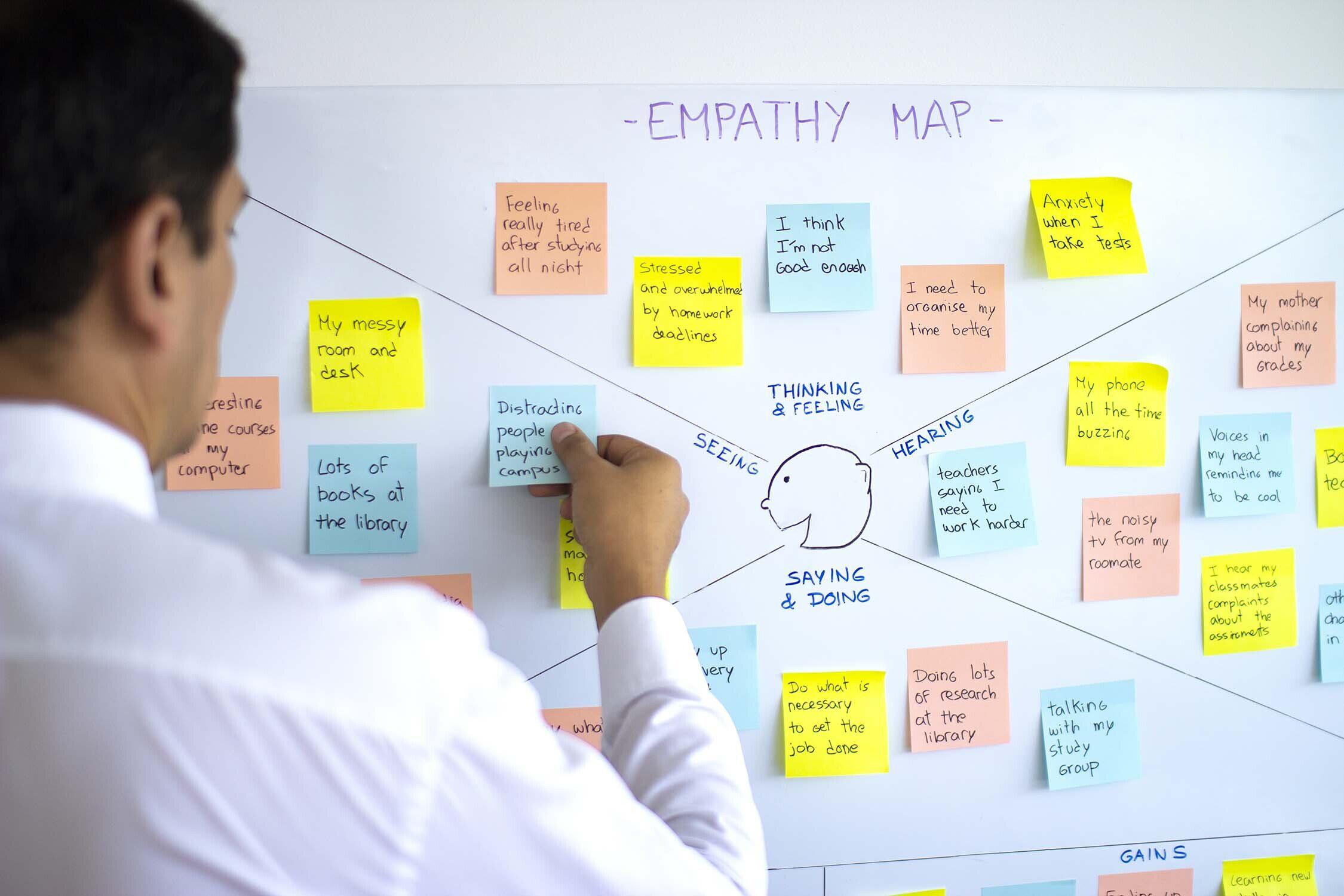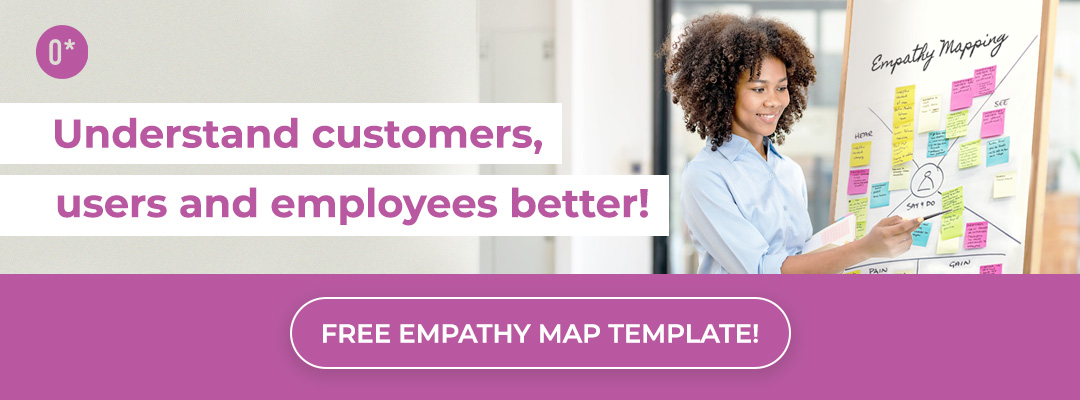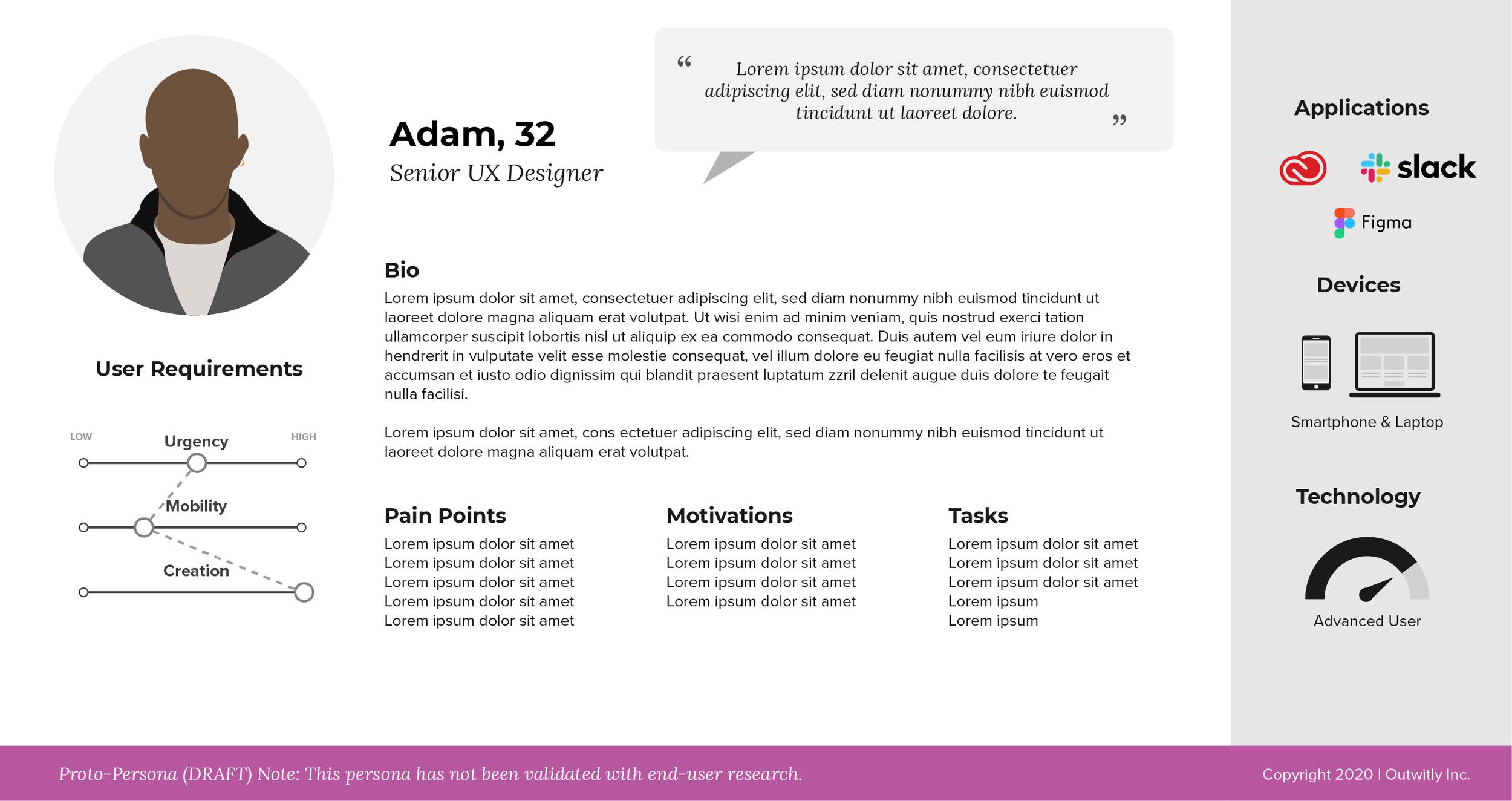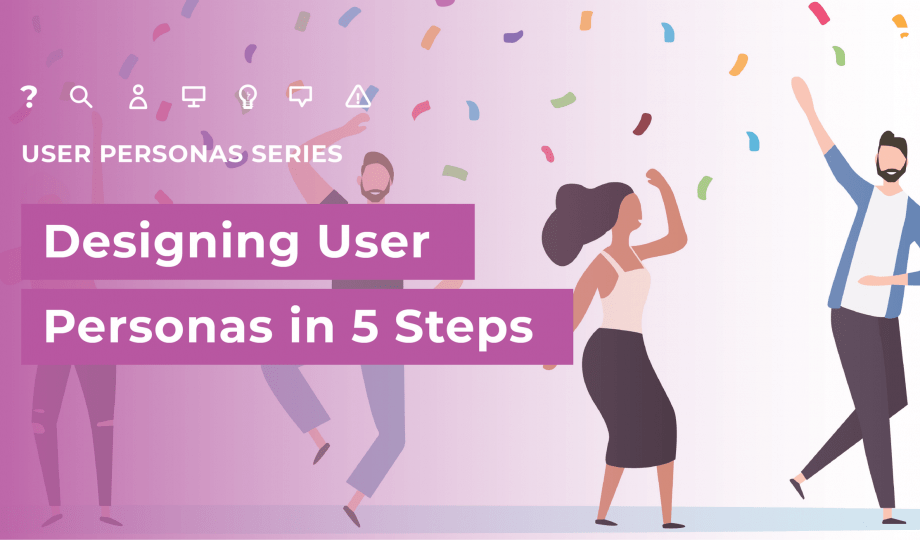What can you do when you don’t have the time nor money to conduct research with real end-users––but you still want to start implementing human-centered design (HCD) best practices at your organization?
While we always advocate for conducting user research, we also understand how difficult it can be to get research prioritized. If you’re always putting out fires and responding to product and/or engineering requests, or if you’re working with limited resources and a small team, it can be tough to split your time between design and research activities. Maybe your company isn’t high enough (yet) on the UX maturity scale, and more convincing among execs and decision-makers will need to happen before you can run a research study. Maybe you do have some time to interact with users, but only in a workshop format. Whatever the case, there are design tools you can use now to help colleagues/stakeholders empathize with your users when research projects are not possible.
Two of our favourite research tools in this context include: Empathy Mapping and Proto-Personas.
Building empathy is important, because it can be easy to forget that “we” (designers and stakeholders) are not the end-users. To design effective products and services, it’s crucial to get at what real users actually want and need.
Empathy Mapping
What is empathy?
Empathy is the ability to recognize and share the emotions of another person. In general, it involves seeing and understanding a situation from another person’s perspective, like “walking a mile in their shoes.” It is often paired with (and confused with) sympathy, which is a little different. Sympathy is a feeling of care and concern for another; it does not necessarily involve understanding what the person is going through in a deep way.
In the Human-Centered Design process, empathizing with users/customers is an important first step. It’s crucial that designers, UX researchers, and stakeholders develop an empathetic understanding of the people they are designing products and services for, as well as the main problem(s) they are looking to solve along the way.
Why is it important for product development and service design?
We are all complex beings. Every individual has a lot more going on in their lives than the interactions they have with your product or service. Building empathy is a way for us to begin understanding that complexity. What makes a person “tick”? What do they really care about? What are the other influencing factors in their lives that may impact their experience? We build empathy in design so that the “things” and experiences we create are truly valuable and solve a need. When a product is desirable, valuable, and usable, it builds customer loyalty and increases customer satisfaction––so it makes good business sense to invest in building empathy for your users.
In fact, watch Outwitly’s CEO Sara Fortier, who was featured on CTV News to explore empathy mapping and how it works in both professional and personal contexts!
How can you begin empathy mapping today?
Empathy mapping is a fun activity that teams and individuals can take part in to build empathy for users and customers. It can also be a great exercise between coworkers, friends, and even family members. Best applied in a workshop setting, empathy mapping with real end-users and/or stakeholders will help you to identify existing assumptions, needs, goals, and areas for further research.
A typical empathy-mapping group exercise will take anywhere from 30 minutes to an hour. We normally conduct the activity in six stages; by the end, you should come away with several user personas to help your team make more strategic product and service decisions.
The six-stage exercise includes:
-
Breaking out the group into teams. Each team should represent one persona and/or user group.
-
Drawing or printing out the empathy map diagram [link].
-
For each persona, teams should brainstorm what the person sees, hears, thinks, and does using post-it notes.
-
Brainstorming and listing their pains and gains.
-
Presenting the empathy maps to the rest of the team or stakeholders to gather feedback and make updates.
-
Building your personas! (or Proto-Personas–see the section below).
Proto-Personas
Before we dive into proto-personas and how to use them effectively, let’s recap what user personas are and why they are so crucial for service designers, UX researchers, and product/service teams. We also have a fantastic three-part blog series on User Personas that serves as a great starting point!
Foremost, personas are archetypes that represent the characteristics, values, motivations, behaviours, and pain points of end-users. They are realistic––and should be based on ethnographic research with users or customers, such as in-depth interviews and contextual observations.
Why are personas so crucial for business? Personas can:
-
Increase the quality and consistency of the products you design. In other words, ensure products are always designed with a persona in mind to ensure they provide value and a consistent user experience.
-
Serve as beacons or guides to keep your team aligned. As a team, you can ask: how would this persona feel about this feature? How would this feature serve this persona’s motivations and help with their pain points?
-
Serve as tie-breakers. Referring back to your personas can help your team make more strategic and efficient decisions without the back-and-forth.
-
Take the designer/team out of “the user.” Remember, you are not the user! Personas can help remind teams of this fact.
-
Help to prioritize features and goals. As reference tools, personas help teams prioritize which problems to solve for first.
-
Build empathy. As discussed above, understanding your users’ needs, motivations, and challenges ensures that you are creating products and services that provide value.
When you don’t have the resources to create actual personas, you can create Proto-Personas (also called “Proxy Personas”). “Proto” refers to a “prototype” or test persona, and “Proxy” is defined as a substitute or replacement for another person.
Proto-Personas, then, are based on the assumptions of stakeholders, and are further checked against actual data (but are not initially based on real data). They are highly useful benchmarks for aligning stakeholders, but they only go so far as to represent who stakeholders think their users are, what they like, and so on. We always recommend that real user personas be developed, as well.
Like user personas based in ethnographic research, proto-personas generally contain the same features:
-
Name
-
Bio (a brief profile of the user)
-
Demographic information (sex, age, occupation)
-
Pain Points (their daily challenges)
-
Motivations or Goals (what do they care about? what are they trying to achieve?)
-
Tasks (which activities do they undertake in the context of your product/service?)
-
Technology Expertise (Low, Medium, or High)
Creating Proto-Personas
Two main activities we recommend for crafting strong proto-personas include talking to proxy users and holding a workshop with stakeholders/team members.
-
Interview/talk to proxy users. As the name suggests, proxy users are people in your organization who are not customers, but are close enough to the customers you’re studying to serve as substitutes (e.g. they have a lot of product knowledge or may support real users as part of their job). To build your proto-personas, we suggest interviewing proxy users and having them help you to craft the personas. You can focus on questions like: “What are the different user types or categories?”; “What are their biggest challenges?”; “What are the characteristics that make these users similar or different to one another?” and so on. Of course, be aware that there are some obvious challenges to working with proxy users. For example, they normally cannot provide a nuanced picture of the real users you are trying to study–they may only be able to present a highlight reel of general motivations and goals.
-
Build proto-personas in collaboration with stakeholders and team members in a workshop. Who should you invite to this workshop? Consider inviting three tiers of team members: 1) front-line workers or customer support people who interact with customers daily; 2) delivery team workers (the people who will actually design and develop the product/service); and 3) Management and executives (both product and marketing)––because after all, this is an exercise about building empathy for users and gaining buy-in from higher-level stakeholders. A good tip for running this type of workshop is to break participants into teams, and assign each team one persona (you may have 4-6 personas depending on your user groups). As one of the first exercises, ask each team to fill out an empathy map, validate their empathy maps with the entire group, and finally use that empathy map to inform the proto-personas they are crafting. Come to the workshop armed with templates, and learn more about how to facilitate a great design workshop here!
Problems with Proto-Personas
Be a little wary, of course. While proto-personas are good tools for building empathy and getting a quick idea of what you need to design (and for who), there are a few things to look out for when you aren’t talking to real users:
-
Stakeholders may use them as the “be all and end all” when making decisions. To avoid this, we recommend keeping your proto-personas in draft format ONLY, and clearly labelled as proto-personas. You do not want these to appear as “final”, because then there may be no incentive to conduct real user research to back them up. And if your team is really pushing to give them a final, glossy “look & feel”, again––clearly label them as “proto-personas.”
-
They are built from assumptions. Always keep this in mind when referencing your proto-personas. Be mindful of what you don’t know––we even suggest including an additional slide/page that includes the questions that remain answered in your proto-personas.
-
They aren’t specific enough. Since proto-personas are not built from user research data, they may be lacking critical details, or they could be plain wrong in some cases. This is why we recommend validating them with real users, or using the proto-personas as a proof of concept with your stakeholders to launch a real research study. In other words, show them that proto-personas are valuable, and make a business case for why backing them up with research would be even more valuable.
Investing in user research is incredibly valuable––but when that’s not possible, empathy-mapping and proto-personas are two great design research tools to get your team started!






